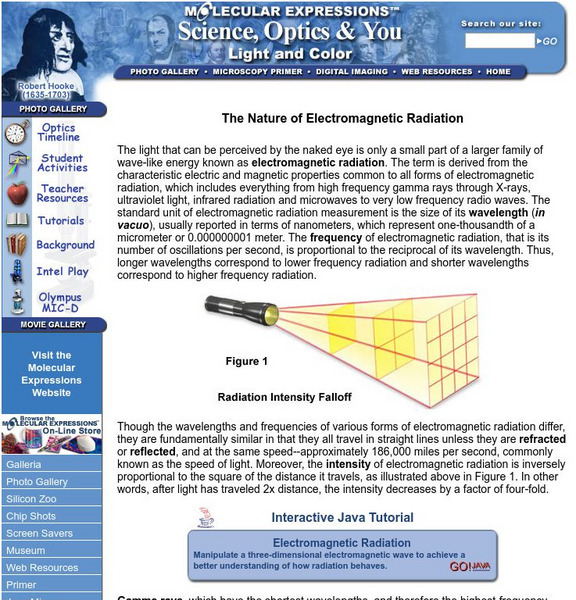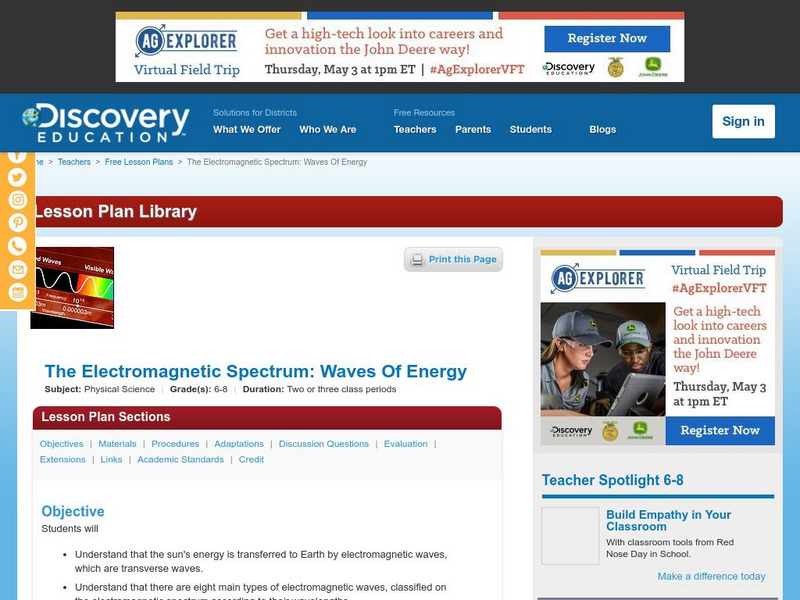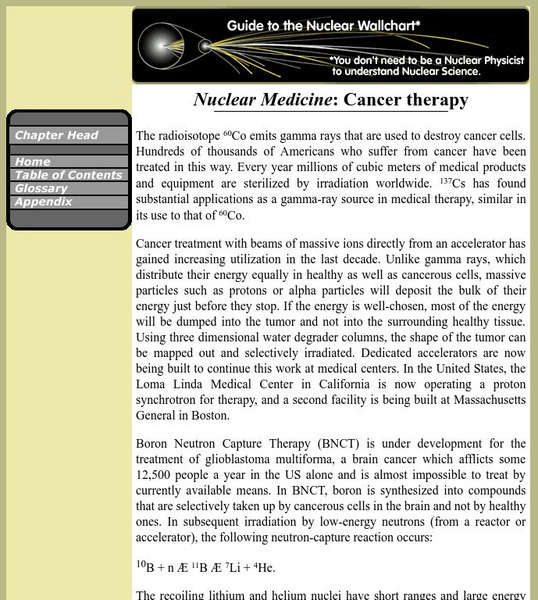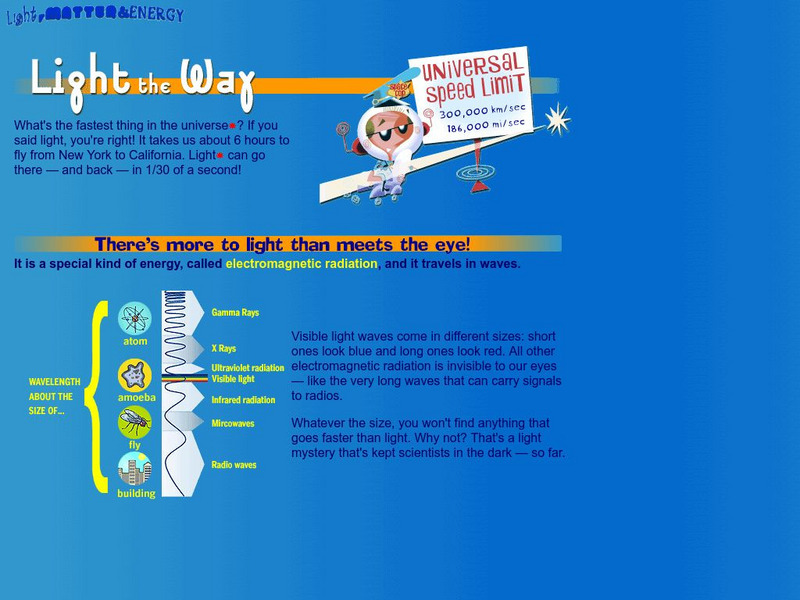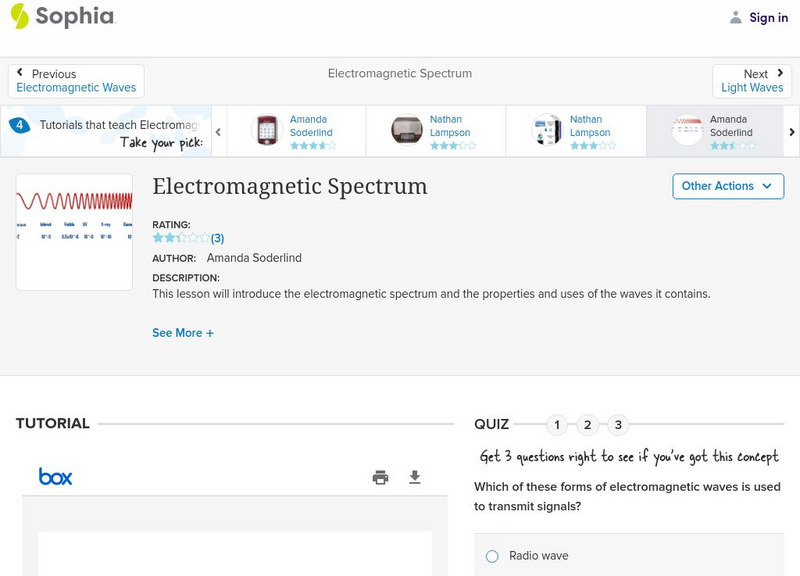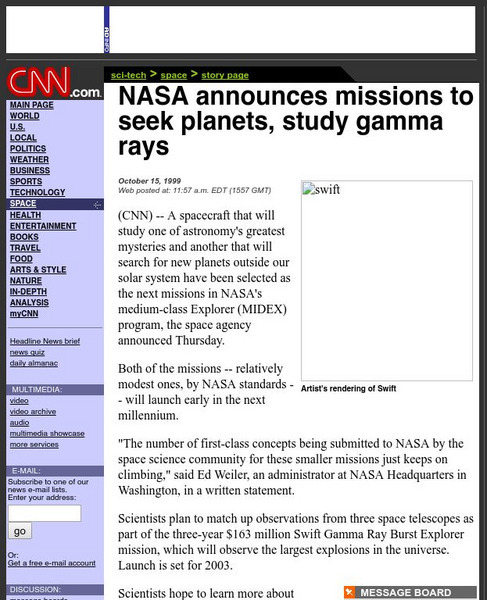Florida State University
Florida State University: Nature of Electromagnetic Radiation
This site from The Florida State University provides an informational page on electromagnetic radiation discusses the characteristics and properties of its many forms including X-rays, gamma rays, ultraviolet radiation, infrared...
Oklahoma Mesonet
Oklahoma Climatological Survey: Overview of Radiation
This site details what radiation is, the physics of radiation, and radiative transfer as it occurs in nature. Content explores the electromagnetic spectrum, electromagnetic waves, properties of radiation, and solar radiation.
Discovery Education
Discovery Education: The Em Spectrum: Waves of Energy
Students are introduced to the electromagnetic spectrum through this group research activity. Each group investigates a different wavelength range within the em spectrum and reports back to class. Discussion ideas also included.
Other
American Institute of Physics: Marie Curie and Radioactivity
A very readable account of the discovery of radioactivity and its properties.
BBC
Bbc: Gcse Bitesize: Radiation Treatment
X-rays, gamma rays and beta particles are all used in medicine to treat internal organs. X-rays are produced by firing electrons at a metal target and gamma rays are emitted by the nucleus of radioactive atoms. Gamma rays are used to...
NASA
Viewing the Violent Universe: What Are Gamma Rays?
The universe produces a broad range of light, only a fraction of which is visible to our eyes. Gamma rays are nonvisible light, which also includes x-rays, ultraviolet light, infrared radiation, and radio waves.
Lawrence Berkeley National Laboratory
Berkeley Lab: Nuclear Medicine: Cancer Therapy
Use this site to learn how gamma rays and other forms of treatment are used to destroy cancer cells.
Lawrence Berkeley National Laboratory
Berkeley Lab: Industrial Applications
Features an exploration of the many common industrial applications that use radioisotopes including smoke detectors, agriculture, arts and humanities, and the automobile industry.
American Museum of Natural History
American Museum of Natural History: O Logy: Light, Matter, Energy: Light the Way
What is electromagnetic radiation and how does it work? Review a captioned graphic that explains electromagnetic radiation and the visible and invisible types of radiation on the electromagnetic spectrum.
Lawrence Berkeley National Laboratory
Berkeley Lab: Measuring Energy Levels
This Guide to the Nuclear Wallchart is an online textbook geared to teachers. Each topic related to nuclear energy is isolated into various topics. This particular chapter explains how to measure nuclear energy levels.
Sophia Learning
Sophia: Electromagnetic Spectrum: Lesson 2
This lesson will introduce the electromagnetic spectrum and the properties and uses of the waves it contains. It is 2 of 4 in the series titled "Electromagnetic Spectrum."
Sophia Learning
Sophia: Electromagnetic Spectrum: Lesson 3
This lesson will introduce the electromagnetic spectrum and the properties and uses of the waves it contains. It is 3 of 4 in the series titled "Electromagnetic Spectrum."
Sophia Learning
Sophia: Electromagnetic Spectrum: Lesson 4
This lesson will introduce the electromagnetic spectrum and the properties and uses of the waves it contains. It is 4 of 4 in the series titled "Electromagnetic Spectrum."
Sophia Learning
Sophia: Electromagnetic Spectrum: Lesson 1
This lesson will introduce the electromagnetic spectrum and the properties and uses of the waves it contains. It is 1 of 4 in the series titled "Electromagnetic Spectrum."
NASA
Nasa: Imagine the Universe: "Nasa Detects One of Closest"
Site provides the article, "NASA Detects One Of Closest And Brightest Gamma Ray Bursts." Provides links to learn more about gamma rays and black holes as well as other resources.
NASA
Nasa: Imagine the Universe: Gamma Ray Astronomy Satellites and Missions
"We present the many satellites which have detected electromagnetic radiation through the 1960s, 70s, 80s, and 90s." Visit this site to read more about the development of satellites throughout the history of gamma-ray astronomy. Graphics...
Ducksters
Ducksters: Physics for Kids: Types of Electromagnetic Waves
Kids learn about the types of electromagnetic waves in the science of physics including microwaves, infrared, ultraviolet, radio, x-rays, and gamma rays.
CNN
Cnn: Nasa Announces Missions to Seek Planets, Study Gamma Rays
A news article about NASA's plans to learn more about gamma rays and discover more planets launched in 1999.


